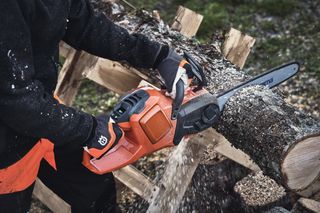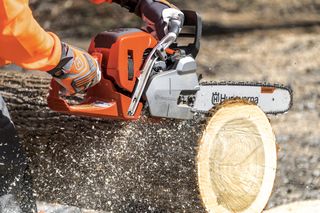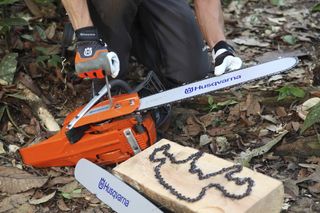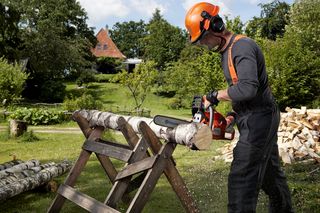
How to choose the best chainsaw for the job
When it comes to choosing the best chainsaw for the task at hand, there’s a little more to it than a simple case of, “that’s got a chain, I’ll take it!” Chainsaws come in all shapes and sizes. From larger petrol-powered machines to compact cutting-edge battery models, each provide their own benefits for different cutting tasks.

Before jumping at the first model you come across, there are a few questions to ask yourself that can help you find that perfect fit. How often will you use your chainsaw? How experienced are you with it? What type of wood will you be cutting? And where do you intend on using it the most?
To give you a nudge in the right direction, here are our top tips on how to choose the best chainsaw for the job.
All-Round Chainsaws
All-round chainsaws are the most commonly used saw by property and landowners. As the name suggests, they are a great choice for a variety of everyday tasks. Built in a similar way to professional saws - albeit, with reduced power - they are great for occasional woodcutting and felling tasks. However, for daily use over extended periods of time, professional saws are a better option. All-round chainsaws are a great choice for:
- Felling and delimbing small and medium-sized trees.
- General woodwork tasks in the garden.
- Occasionally preparing and cutting firewood.
- Carpentry and artistic woodwork creation.
Consumer Chainsaws
Consumer chainsaws are designed for those looking for a moderately powerful saw for occasional use around the home. Similar to all-round saws, they are typically more compact and with more basic features. However, they are a popular choice for those new to chainsaws or with limited experience looking for a starter tool to familiarise themselves with. Common uses for consumer saws include:
- Removing dead and diseased branches from small trees.
- Occasionally cutting and preparing firewood.
- Occasional woodworking tasks of a small nature.
- General pruning and removal of small tree trunks.
- Cutting fence posts and breaking down wood pallets.
Professional Chainsaws
Professional chainsaws have a similar look and feel as their all-rounder counterparts. However, some of the main differences lie in the power and performance of the tool. Designed for regular use on a professional level, they typically draw focus to power and output ideal for greenspace workers and landscaping businesses. Uses for a professional chainsaw include:
- Felling and delimbing small, medium and large trees.
- Cutting both wet and dry wood.
- Preparing and cutting firewood on a commercial scale.
- Creating and cutting fence posts and wooden furniture.
Tree Care Chainsaws
Tree care chainsaws, also known as top handle saws, are created for professional use in arborist work. These typically offer the most power for continual use with a focus on safety, as they are used when working in a tree top canopy from height or while suspended mid-air.

Best Chainsaws For Specific Tasks
Now we’ve covered the basics for each of the four main types of chainsaws available on the market, let’s take a closer look at some pointers designed to help you choose the best chainsaw for the jobs you need to complete. This section covers guide bars, different chainsaw sizes and power types.
Understanding Bars
When looking at all-round and consumer chainsaws, the bar will often be shorter and lighter. This makes them ideal for those with little to no experience with chainsaws, as it improves ease of use and reduces fatigue on the arms. However, the trade-off here is that the smaller guide bars limit the diameter and depth of wood you can work with.
With professional saws, bars are typically longer. This allows the operator to deal with trees of all sizes, perform more advanced cuts and improve reach into denser wood. Of course, the larger bar ultimately increases the weight of the chainsaw - though there are accessories designed to improve usage and minimise fatigue over extended periods of time.

Choosing The Right Size
One of the most important aspects in choosing a chainsaw that fits your needs is by determining the appropriate size and power you require for the job. Usually, the power of the engine is proportional to the length of the chainsaw’s guide bar, meaning the longer the guide bar, the more powerful the engine is to support it.
Engine size is measured in cubic centimetres (cc) however a larger engine size does not always equate to more power. The power of a chainsaw is determined by the piston displacement and is measured in kilowatts (kW) for petrol machines. A larger engine with higher kW generates more power, than a smaller engine with lower kW.
To determine the size and power of the chainsaw you need for the job, consider these factors:
Type of wood - hardwood and large trees require much more power than softwood or smaller trees. Professionals will require the power offered by a large chainsaw as a small chainsaw would be placed under unnecessary strain and wear.
Experience - for those who are familiar and comfortable with chainsaws, larger models are typically the way to go. For those who are uncomfortable or newer to use, you will appreciate the lightweight maneuverability offered by a smaller model.
Battery Vs Petrol Saws
There are pros and cons to battery and petrol chainsaws, so it is important to consider both options prior to purchase. Today’s battery-powered chainsaws are able to offer the same raw power and performance as their petrol counterparts for the majority of chainsaw types. However for large professional saws, petrol power still has the leading edge for now and they will keep going as long as you keep them topped up with fuel.
Battery-powered chainsaws provide a quiet, low-vibration, lightweight and emission-free alternative for homeowners and those in residential areas. Modern designs combined with advanced lithium-ion batteries enables operators to perform everyday cutting tasks to a professional-level finish - without disrupting the neighbours.
For landowners, the battery powered 340i chainsaw is a popular choice, offering a powerful and versatile option for felling, pruning, carpentry and firewood. Featuring a narrow body design and optimised centre of gravity, enjoy maximum maneuverability no matter the task. Being battery powered, it also offers the same low vibration, low noise and zero direct emissions benefits and has tool-less chain tensioning built in.
Battery Powered Top Handled Chainsaws are rapidly becoming the go-to option for many arborists thanks to their quiet operation, no resetting or idling between cuts, fewer vibrations, no exhaust emissions, lighter weight load and a push start button - making working at height much easier.
Looking at the different fuel types, battery-powered chainsaws are also lighter than their petrol-power alternatives. The weight is fixed into position as there are zero liquids moving in a tank, improving usage and maneuverability. Choosing between the two types is more down to personal preference than anything else, with both offering their own unique benefits.

Chainsaws for Common Chainsaw Tasks
- General Garden Tasks - 120i
- Occasional Cutting Firewood - 120e Mark II
- Felling Small Trees - 135 Mark II
- Felling Medium Trees - 445 e-series II
- Carpentry/Woodwork - 460
- Felling Large Trees - 572 XP
- Forestry Work - 3120 XP
- Arborist Tasks - T540i XP
Find Your Perfect Fit
At Husqvarna, we want you to get the most out of everything you do - whether at home or at work. If you’re still not 100% sure about which chainsaw is best for your needs or whether you need accessories, parts and additional bars; our authorised dealers are always happy to help. View our full range of homeowner and professional chainsaws to consider the specs and make comparisons and purchasing. Some models have the option to collect in-store or you can visit your local Husqvarna dealer.









